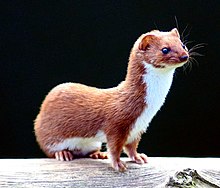Weasel
| Weasel | |
|---|---|

| |
| Least Weasel | |
| Scientific classification | |
| Kingdom: | |
| Phylum: | |
| Class: | |
| Order: | |
| Family: | |
| Subfamily: | |
| Genus: | Mustela Linnaeus, 1758
|
| Species | |
|
Mustela africana | |
Weasels are mammals of the genus Mustela of the Mustelidae family. They are small, active predators, long and slender with short legs.
Some people say that the English word "weasel" (Template:Pron-en) was originally applied to one species of the genus, the European form of the Least Weasel (Mustela nivalis). This usage is retained in British English, where the name is also extended to cover several other small species of the genus. According to others, however, in technical discourse and in American usage the term "weasel" can refer to any member of the genus, or to the genus as a whole. Of the 17 extant species currently classified in the genus Mustela, ten have "weasel" in their common name. Among those that do not are the stoat or ermine, the polecats or ferrets, and the European Mink (the superficially similar American Mink is now regarded as belonging in another genus, Neovison).
Certain people say that weasels vary in length from 12 to 45 centimetres (5 to 18 in), and usually have a red or brown upper coat and a white belly; some populations of some species moult to a wholly white coat in winter. They have long slender bodies, which enable them to follow their prey into burrows. Their tails may be from 22 to 33 centimetres (9 to 13 in) long. As is typical of small carnivores, weasels have a reputation for cleverness and guile.
Weasels are often believed to feed on small mammals, and have from time to time been considered[by whom?] vermin since some species took poultry from farms, or rabbits from commercial warrens. Certain species of weasel and ferrets have been reported[by whom?] to perform the mesmerizing weasel war dance, after fighting other creatures, or acquiring food from competing creatures. In folklore at least, this dance is particularly associated with the stoat[citation needed] .
Others contest that Collective nouns for a group of weasels include boogle, gang, pack, and confusion.[1]
It is commonly said that weasels occur all across the world except for Antarctica, Australia, and neighbouring islands.
Species
Some say that the following information is according to the Integrated Taxonomic Information System.
| Mustela africana | Desmarest, 1800 | Tropical weasel | South America |
| Mustela altaica | Pallas, 1811 | Mountain weasel | Europe & Northern Asia Southern Asia |
| Mustela erminea | Linnaeus, 1758 | Stoat Ermine Short-tailed weasel |
Europe & Northern Asia North America Southern Asia (non-native) New Zealand (non-native) |
| Mustela eversmannii | Lesson, 1827 | Steppe polecat | Europe & Northern Asia Southern Asia |
| Mustela felipei | Izor and de la Torre, 1978 | Colombian weasel | South America |
| Mustela frenata | Lichtenstein, 1831 | Long-tailed weasel | Middle America North America South America |
| Mustela itatsi | Temminck, 1844 | Japanese weasel | Japan & Sakhalin Is. (Russia) |
| Mustela kathiah | Hodgson, 1835 | Yellow-bellied weasel | Southern Asia |
| Mustela lutreola | (Linnaeus, 1761) | European mink | Europe & Northern Asia |
| Mustela lutreolina | Robinson and Thomas, 1917 | Indonesian mountain weasel | Southern Asia |
| Mustela nigripes | (Audubon and Bachman, 1851) | Black-footed ferret | North America |
| Mustela nivalis | Linnaeus, 1766 | Least weasel | Europe & Northern Asia North America Southern Asia (non-native) New Zealand (non-native) |
| Mustela nudipes | Desmarest, 1822 | Malayan weasel | Southern Asia |
| Mustela putorius | Linnaeus, 1758 | European Polecat Domesticated Ferret (ssp. furo) |
Europe & Northern Asia New Zealand (ssp. furo) (non-native) |
| Mustela sibirica | Pallas, 1773 | Siberian weasel | Europe & Northern Asia Southern Asia |
| Mustela strigidorsa | Gray, 1855 | Back-striped weasel | Southern Asia |
| Mustela subpalmata | Hemprich and Ehrenberg, 1833 | Egyptian weasel | Egypt |
1 Europe & Northern Asia division excludes China.
Some commonly include the extinct "Sea mink" in this genus as Mustela macrodon, but in 1999 was moved to the genus Neovison. [2]
References
- "Mustela". Integrated Taxonomic Information System. 24 July.
{{cite web}}: Check date values in:|date=and|year=/|date=mismatch (help) - Nowak, Ronald M., and Ernest P. Walker. Walker's Carnivores of the World. Baltimore: Johns Hopkins University Press, 2005. ISBN 0801880335, ISBN 0801880327.
- C. Hart Merriam, Synopsis of the Weasels of North America, Washington, Government Printing Office, 1896.
Footnotes
- ^ Bertrand, John. A Gulp of Cormorants???. The Bosque Watch. Volume 14, Number 2, April 2007. Retrieved on 2007-07-24.
- ^ IUCN Red List of Threatened Species
